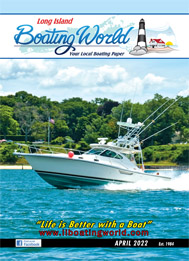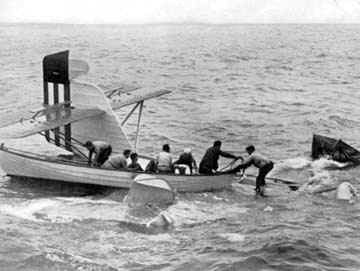
Each month, an interesting aspect of the world’s oldest continuous maritime service will be highlighted. The men and women of the United States Coast Guard follow in the fine tradition of the brave mariners who have served before them. As sentinels and saviors of the seas, the United States Coast Guard proudly continues its commitment to honor, respect & devotion to duty to maintain their vigil – Semper Paratus.
A Question of Risk versus Gain –
The Loss of the V-164
As the slender bow of the Atlantis easily sliced through the warm waters of the Atlantic Ocean, below decks, George Priest regretted his decision to go to sea. A former Boston stock broker, Priest had signed on as a seaman aboard the research vessel of the Oceanographic Institute of Woods Hole, Massachusetts to assist in a bout of ill health. Now suffering from pneumonia, he direly needed to get to a hospital. With a top speed of only seven knots, it would take the Atlantis eighteen or more hours to get to the closest port. After a radio consult with physicians at the Marine Hospital in Stapleton, Captain Frederick S. McMurray realized that Priest needed more assistance then he and his crew could provide. Captain McMurray ordered a radio call be issued to request assistance from the United States Coast Guard.

Lieutenant William L. Clemmer scribbled down the latitude and longitude on a tiny pad of paper. Shoving the pad into the pocket of his flight jacket, he ran out to the Hall PH-2/3 flying-boat prepped on the tarmac at Floyd Bennett Field. His crew consisted of his co-pilot, a yeoman, a radioman, and three flight mechanics. Quickly strapped into his seat, Lieutenant Clemmer passed orders to his co-pilot, John Radan, in a confident, calm and clear manner. Within seconds, the two supercharged Wright Cyclone engines, located above and aft of the cockpit, coughed loudly and the large Curtiss controllable propellers began to spin into action. As the ground crew removed the chocks from the flying-boat’s detachable set of landing gear, Lieutenant Clemmer eased the V-164 toward the ramp. As the V-164 slid into the water, the flight crew readied for a hurried lift-off. Time was of the essence. Within minutes, the V-164 eased into the morning sky. Banking the aircraft, Lieutenant Clemmer steered the V-164 on her new course of south east toward the reported position of the Atlantis. The V-164 and her crew of Coastguardsmen were on their way to try and save the stricken seaman.
Roughly two hours later, Lieutenant Clemmer and his co-pilot spotted the Atlantis. Circling the ketch, the two pilots discussed the weather and sea conditions. With cross swells and thunder squalls, it was less than ideal. Despite the conditions, Lieutenant Clemmer passed word to his crew – they were making their approach. Landing safely in the swirling swells, the flying boat transited closer to the research vessel. Aboard the Atlantis, Captain McMurray supervised as his crew lowered a small boat into the swells with the patient. Despite the conditions, the Coastguardsmen safely pulled the stricken seaman aboard the V-164. With Priest aboard and resting comfortably on a stretcher for the transit to land, Lieutenant Clemmer passed word to his crew. Prepare for takeoff. Aboard the Atlantis, Captain McMurray and his crew watched as the lumbering seaplane increased its speed across the water. Lurching from the swells, the V-164 was roughly twenty feet above the surface of the seas when the nose of the seaplane slammed into a surging swell. Captain McMurray and his men thought they heard an explosion. The men aboard the Atlantis immediately sprang into action and launched the small boat to the scene. The crew arrived at the sight of the crash within moments. The V-164 was slowly sinking beneath the surface. The crew carefully pulled bodies from the wreckage. Several of the men spotted were injured due to the horrific crash into the waves. Before a line could be placed on the wreckage, the V-164 slipped beneath the waves and into the depths.
The Atlantis issued a radio transmission to the United States Coast Guard. Two of the men aboard were injured. Three men, including Lieutenant Clemmer, co-pilot Radan and the injured seaman from the Atlantis had not been recovered. Within minutes of the broadcast and subsequent updates of the survivors and lost, several assets of the United States Coast Guard were ordered to the scene. At Floyd Bennett Field, Lieutenant Watson Burton alighted aboard the V-166 and from Cape May, New Jersey, Lieutenant Burke in the V-170 soared into the sky on his way to the scene. The Coast Guard Cutter Campbell was dispatched to take on the injured Coastguardsmen and the cutters Pontchartrain and Comanche, both on station in the vicinity, were also dispatched the Atlantis’ location. While the various assets of the Coast Guard raced to the scene, Captain McMurray and his crew searched for debris and the remaining men. Their efforts were fruitless.
Approximately an hour and a half after the crash, Lieutenant Burke, piloting the V-170 arrived over the Atlantis. After radio communications with the Atlantis were established, it was determined that Lieutenant Burke would remain on station and scan for any sight of the missing men. A landing and removal of the injured was deemed too hazardous. Calculating his fuel consumption, Lieutenant Burke remained on station as long as he and his crew could do so. As the V-170 took one last pass over the scene and banked southward toward Cape May, New Jersey, the U.S.C.G.C. Campbell, with top speed, continued toward the area. Several hours later, under the cover of darkness, the injured Coastguardsmen were successfully transferred from the Atlantis onto the cutter. At full speed, the cutter raced westward toward Stapleton. The following morning, the survivors were transferred to the Marine Hospital for treatment and recovery.
In the immediate wake of the loss of the V-164, a board of inquiry was convened under the command of Captain Ralph W. Dempwolf, commanding officer of the New York District of the Coast Guard. Lieutenant Commander William John Kossler, inspector of seaplane construction, Lieutenant Richard Burke, pilot of the V-170 that assisted in the recovery operations, and Lieutenant Julius J. Jacot of the New York District Office were appointed to the board to investigate the cause of the deadly rescue mission. During the investigation, Captain McMurray of the Atlantis and the survivors of the crash were interviewed. Early thoughts that an explosion heard by the Captain and crew of the Atlantis were nullified after testimony by survivor Machinist Mate Walter B. Salter. The Coastguardsman explained that after landing in the water, he conducted a thorough inspection. During the standard inspection, he ensured that all of the gasoline lines were sealed and he indicated that he did not smell any fumes. Positioned in the aft section of the V-164, he recounted that during the ill-fated take off, he felt two slight bumps as the seaplane was gaining speed. After a third bump, he found himself in the water. He had survived by climbing through a hatch in the fuselage. It was in his opinion that upon impact, the forward section of the seaplane broke off and immediately sank into the sea. With little physical evidence, it was difficult for the investigators to determine the cause of the crash. The inquiry then shifted in its scope and questions were raised as to the safety and efficacy of seaplane-based rescues for some medical situations. Commander Kessler asked Lieutenant Watson Burton, commanding officer of the Coast Guard detachment at Floyd Bennett Field, “Do you, from your experience, consider that the admitted risk involved in landing and taking off a reportedly sick man from a ship at sea is usually subsequently justified?” Lieutenant Burton eased back in his seat and replied, “In my opinion, based on knowledge of a good many cases of medical assistance and on the information of other pilots, the hazard is not justified. I believe that in the majority of cases it is discovered later that the patient is not as sick as reported.” Lieutenant Burton continued his response noting that “Unfortunately, it is difficult to determine by radio just which we are justified in assisting and which are the false alarms. Many times the information comes from the master of the ship, who is not qualified to make a sound analysis or diagnosis.” Subsequent testimony from Lieutenant Hawes, a medical officer in the Medical Corps of the U.S. Naval Reserve, provided examples of harrowing rescues of patients that had been clearly misdiagnosed and had placed aircrews and their equipment in unnecessary rescue situations. Ultimately, in Lieutenant Hawes’ opinion, short of severe medical emergencies and shipwrecks, the United States Coast Guard “would do well to abandon such flights.” The Board of Inquiry concluded that the V-164 had struck a swell during take-off and the subsequent crash into the sea had led to the loss of the two Coastguardsmen, the pneumonia stricken Priest, and the complete destruction and loss of the V-164.
With advances in technology and training, rescue missions utilizing seaplanes continued in the spirit of the service’s overarching mission. With the World plunged into a global conflict in the years that followed, the United States Coast Guard and her sister services developed new methods for mercy flights, rescues at sea, and other operational situations. These lessons coupled with the evolutionary aircraft developments assisted in advancing at sea rescues for both aircraft, small rescue boats, and the service’s larger cutters. Ultimately though, with every mission hazards could only be minimized and never thoroughly removed from the situation. The mercy missions, no different than the mission tasked to Lieutenant Clemmer, enlisted pilot Radan, and the entire aircrew, continue to this day.
Alighting into the ethereal skies aboard an aircraft or altering course on the surging seas aboard a cutter or small boat, members of the United States Coast Guard, despite the nature of their mission, remain ever-vigilant to answer the call of those mariners in need. It is this dedication to their service’s core values that ensures that Coast Guard personnel will forever stand ready to spring into action to ensure that those in peril are provided an opportunity to survive their harrowing ordeal. Abiding by their service’s motto of “Semper Paratus,” they stand always ready, like the crew of the V-164, to serve as sentinels and saviors of the seas.
